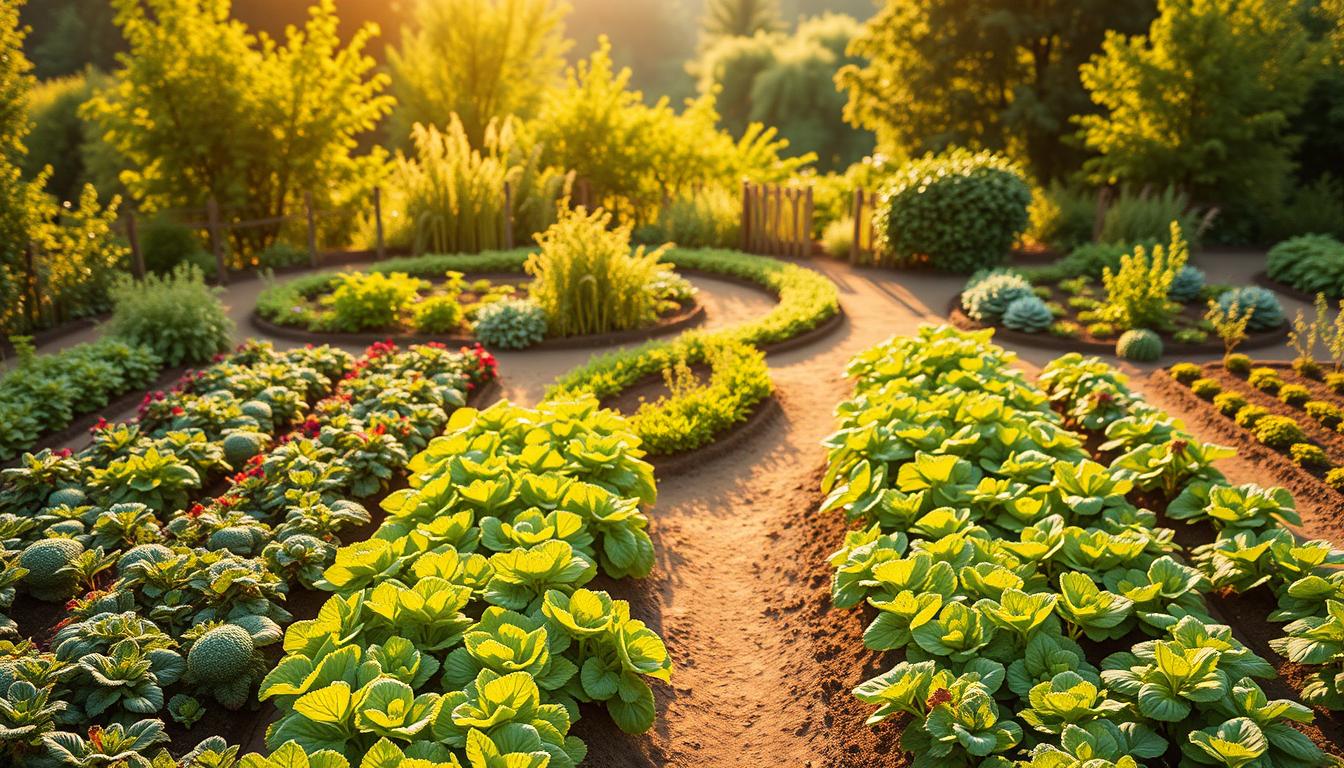Creating a thriving planting area starts with a solid plan. A vegetable garden layout template can help you maximize productivity while keeping your space visually appealing. Whether you’re working with a small yard or expansive raised beds, these plans offer versatility for every setting.
Many gardeners have found success by using structured layouts. These designs not only reduce maintenance but also increase yield. For beginners, approaches like square-foot gardening make the process simple and rewarding.
Tools like the Almanac Garden Planner provide over 800 curated layouts to inspire your project. Additionally, considering USDA hardiness zones ensures your plants thrive in your local climate. With the right plan, your space can become a productive and beautiful retreat.
Key Takeaways
- Structured plans boost productivity and aesthetics.
- Versatile designs work for small yards and raised beds.
- Reduced maintenance and increased yield are key benefits.
- Beginner-friendly methods like square-foot gardening simplify the process.
- USDA hardiness zones ensure plant success in your area.
1. Why a Vegetable Garden Layout Template is Essential
Strategic planning is the backbone of a productive growing area. Without a clear design, common mistakes like overcrowding or poor sun exposure can hinder your results. A well-thought-out plan ensures your plants have the space and resources they need to thrive.
Using grid-based templates, you can calculate exact plant quantities and avoid wasting resources. Proper spacing alone can increase yield by up to 40%. This method also simplifies crop rotation, helping you maintain healthy soil between seasons.
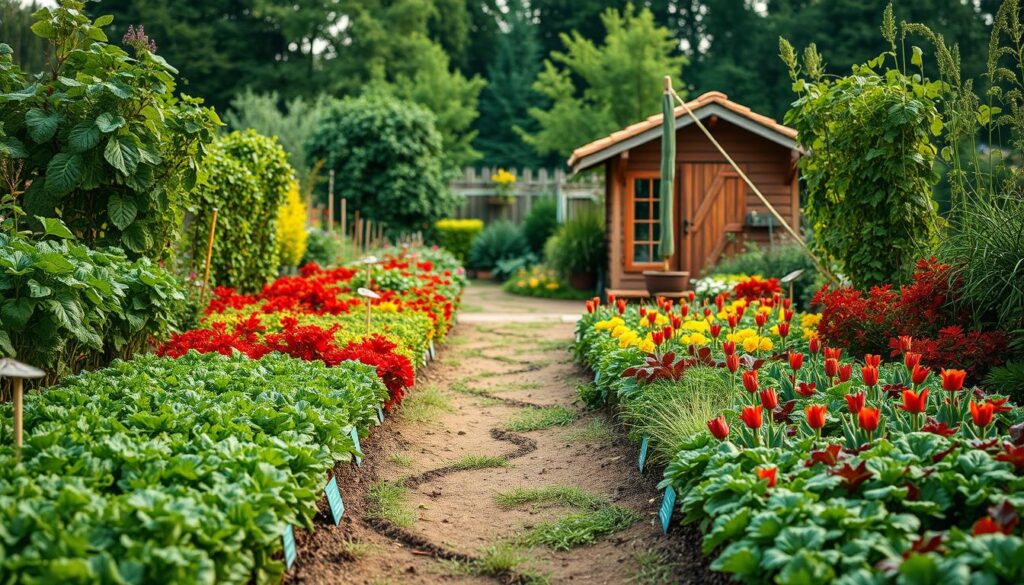
One inspiring example is a Minnesota family who boosted their harvest by 60% after adopting a structured approach. By addressing soil quality and planning water access, they created an efficient and sustainable system.
Companion planting is another benefit of thoughtful designs. Pairing compatible plants can deter pests and improve growth. Whether you’re growing food for your family or experimenting with new crops, a solid plan is your best tool for success.
2. Types of Vegetable Garden Layouts
The way you organize your planting area can make or break its success. Choosing the right structure ensures your plants thrive while making maintenance easier. Let’s explore three popular designs: square-foot, backyard, and raised bed layouts.
Square-Foot Gardening
Square-foot gardening uses a 4×4-foot grid divided into 16 squares. Each square is dedicated to a specific plant, making it ideal for small spaces. For example, lettuce, radishes, and carrots can grow one per square, while cucumbers and pole beans benefit from vertical growing techniques.
This method simplifies crop rotation and maximizes space. It’s perfect for beginners or those with limited room. Winterizing is also easy with cold frames to protect your plants during colder months.

Backyard Designs
Backyard layouts focus on practicality and accessibility. These plans often include pathways for easy movement and protection for pets or kids. You can grow a variety of plants in rows or clusters, depending on your space and preferences.
Companion planting works well here, pairing plants that benefit each other. For instance, tomatoes and basil grow well together, deterring pests naturally. Backyard designs are versatile and can be tailored to fit any family’s needs.
Raised Bed Structures
Raised beds are ideal for areas with poor soil quality. They allow you to control the soil mix, ensuring your plants get the nutrients they need. These structures also reduce bending, making them easier to maintain.
You can grow a wide range of vegetables and plants in raised beds. They’re perfect for creating organized rows and improving drainage. Plus, they add a neat, structured look to your space.
| Layout Type | Best For | Key Benefits |
|---|---|---|
| Square-Foot | Small spaces, beginners | Space efficiency, easy crop rotation |
| Backyard | Families, versatile spaces | Accessibility, companion planting |
| Raised Beds | Poor soil, reduced bending | Soil control, improved drainage |
“The right layout transforms your planting area into a productive and beautiful space.”
3. Designing a Square-Foot Vegetable Garden
A well-organized space can transform your growing experience. Square-foot gardening is a popular method that maximizes productivity in small areas. By dividing a 4×8-foot bed into 32 squares, you can grow a variety of plants efficiently.
Start by creating a grid using nylon twine and stakes. This ensures each square is clearly defined. A succession planting calendar helps you plan for continuous harvests throughout the season. For example, plant radishes early and follow with lettuce in the same square.
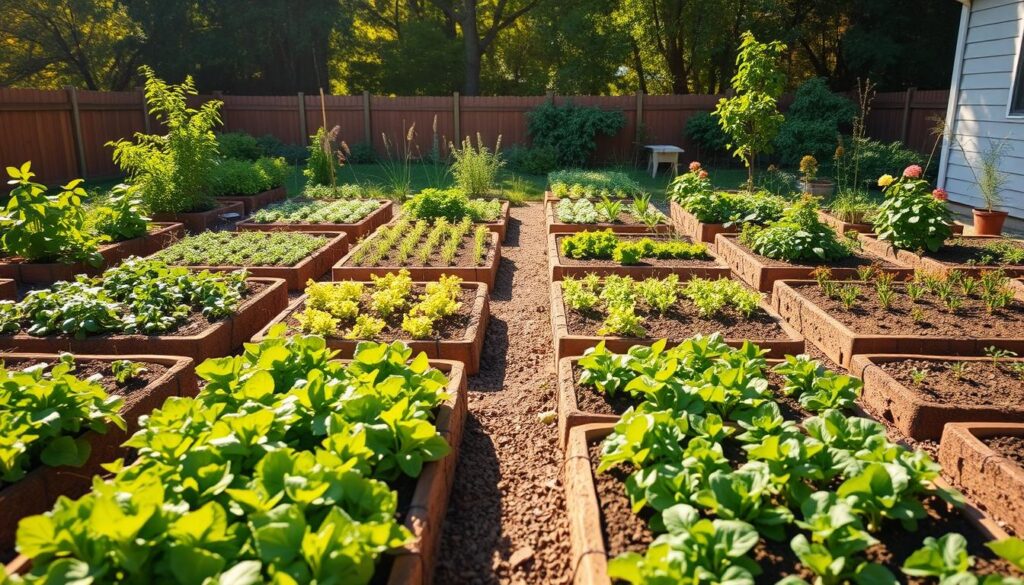
Color-coded planting maps make it easy to visualize your garden plan. Assign colors to specific plants, like red for tomatoes and green for basil. This approach simplifies organization and ensures proper spacing.
Companion planting is another key strategy. Pairing certain plants can improve growth and deter pests. For instance, marigolds and tomatoes grow well together, while basil and nasturtiums naturally repel insects.
| Plant | Companion | Benefit |
|---|---|---|
| Tomatoes | Marigolds | Pest control |
| Basil | Tomatoes | Improved flavor |
| Nasturtiums | Cucumbers | Insect repellent |
For optimal growth, use a soil mix of 1/3 vermiculite, 1/3 peat moss, and 1/3 compost. This blend provides nutrients and ensures proper drainage. Vertical trellises, like those made from cattle panels, save space and support climbing plants.
Finally, strategic placement of herbs and flowers can enhance pest control. Basil and nasturtiums are particularly effective at keeping unwanted insects at bay. With these tips, your square-foot garden will thrive and produce abundant yields.
4. Backyard Vegetable Garden Plans
Transforming your backyard into a family-friendly growing space is easier than you think. With thoughtful vegetable garden plans, you can create a space that’s both productive and enjoyable for everyone. From snacking zones to playful structures, these designs cater to families and children.
Start by labeling specific areas as “snacking zones.” These spots are perfect for quick, healthy bites like cherry tomatoes or snap peas. Kids will love picking their own snacks, making the experience interactive and fun.
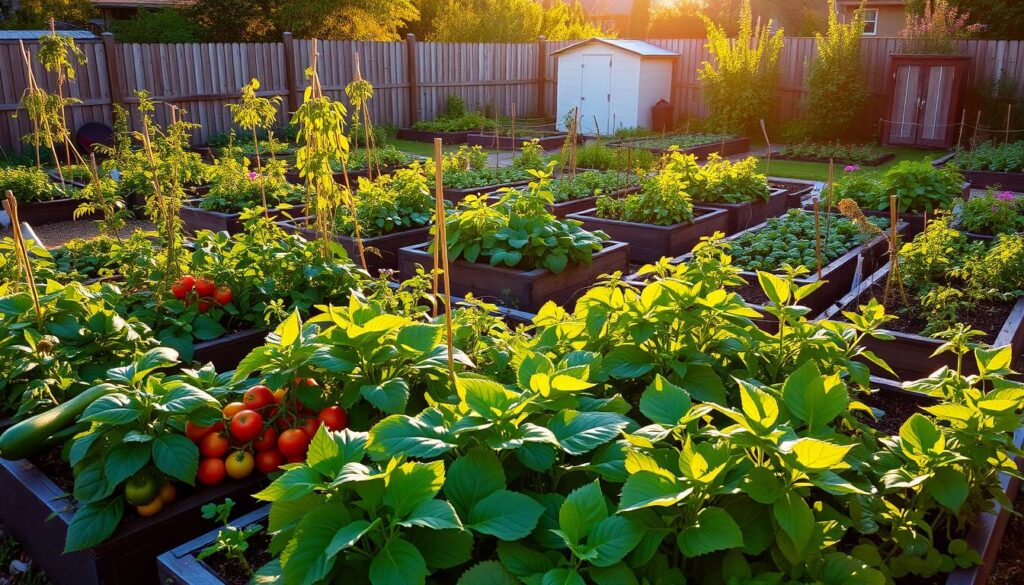
Incorporate a bean teepee play structure to add a playful element. This simple design uses bamboo poles or stakes to create a teepee shape, perfect for climbing beans and imaginative play. It’s a great way to engage children while growing fresh produce.
Border plants like zinnias and borage attract pollinators, ensuring your plants thrive. These colorful additions also add beauty to your space. For added security, consider rabbit-proof fencing solutions to protect your crops.
Plan for a three-season harvest to maximize your yield. Start with spring peas, transition to summer squash, and finish with fall kale. This approach ensures a steady supply of fresh food throughout the year.
Interactive elements like a sunflower house or strawberry stepping stones make the space even more engaging. These features encourage exploration and creativity, making your backyard a favorite spot for kids.
Finally, add a lighting plan for evening enjoyment. Soft, solar-powered lights create a cozy atmosphere, allowing you to enjoy your space even after the sun sets.
| Interactive Element | Purpose |
|---|---|
| Bean Teepee | Play structure for kids |
| Sunflower House | Creative play area |
| Strawberry Stepping Stones | Interactive pathway |
“A well-designed backyard garden brings families together while providing fresh, healthy food.”
5. Raised Bed Vegetable Garden Layouts
Optimizing your growing space with raised beds ensures better soil quality and root health. These structures are ideal for controlling soil composition and improving drainage, making them perfect for a variety of plants.
Start with a 4×8-foot bed plan for efficient use of space. Use a mix of potting soil and compost to create a nutrient-rich environment. This combination supports healthy growth and reduces the need for frequent fertilization.
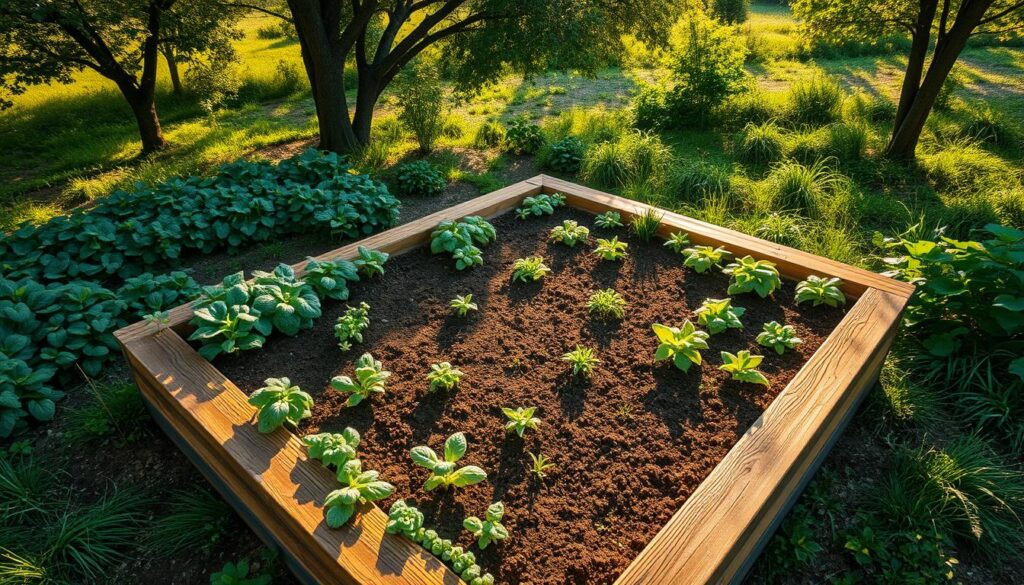
Different plants require varying soil depths. For example, carrots need at least 12 inches, while lettuce thrives in 8 inches. Plan your bed layout accordingly to accommodate these needs.
Interplanting is a smart strategy to maximize space. Pair fast-growing radishes with slow-growing broccoli. This approach ensures continuous harvests and efficient use of resources.
Install a drip irrigation system to provide consistent water supply. This method conserves water and ensures your plants receive the moisture they need. A well-designed system can save time and effort in the long run.
Implement a crop rotation plan over three years to maintain soil health. Rotating crops prevents nutrient depletion and reduces the risk of pests and diseases. For example, follow leafy greens with legumes to replenish nitrogen levels.
Prepare for winter by planting garlic in October. This hardy crop thrives in colder months and ensures a fresh harvest in spring. Additionally, use trellis systems for indeterminate tomatoes to save space and improve air circulation.
Adjust planting dates based on your USDA hardiness zone. This ensures your plants are sown at the optimal time for your region. For more tips on starting your planting journey, check out this beginner’s guide.
“Raised beds offer a practical and efficient way to grow healthy plants in any space.”
6. Kitchen Garden Layouts (Potager)
A kitchen garden blends beauty and practicality in one space. This design combines vegetables, herbs, and flowers to create a functional yet charming area. Inspired by French potager styles and medieval monastery designs, it’s perfect for those who want both aesthetics and productivity.
The French potager approach uses geometric patterns to organize plants. For example, circular or rectangular beds with borders of boxwood or rosemary topiaries add structure. This method not only looks elegant but also makes maintenance easier.
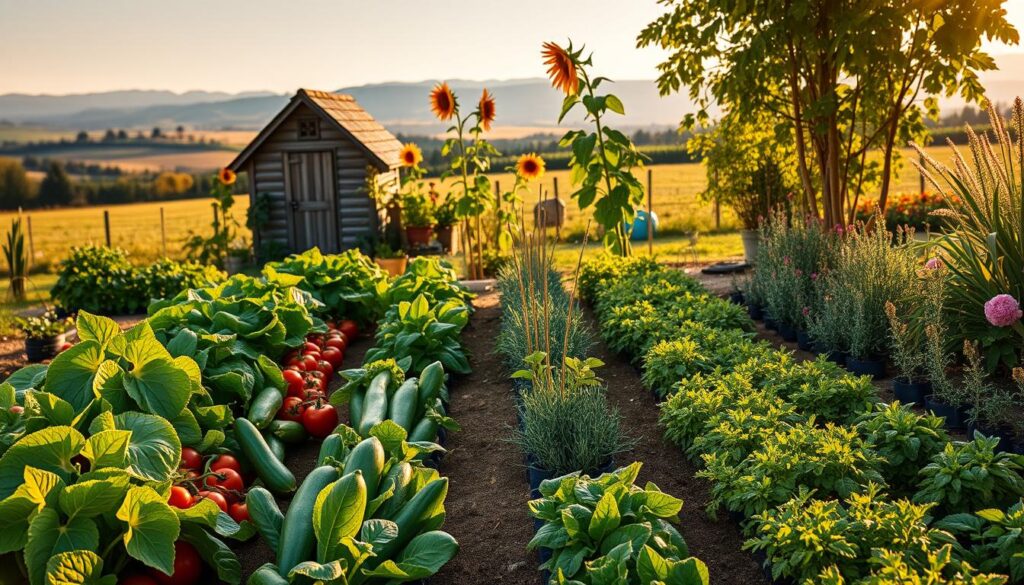
Incorporate culinary themes like a pizza or salsa garden. Plant tomatoes, basil, and peppers together for a functional and fun space. These themed areas are great for families and make harvesting a breeze.
Evergreen plants like boxwood or rosemary topiaries provide year-round structure. Pair them with seasonal flowers like dahlias or marigolds for added color. Cut-flower integration, such as dahlias with zucchini, enhances both beauty and utility.
Pathway materials play a key role in the overall design. Crushed oyster shells add a rustic charm, while bark mulch is a budget-friendly option. Both choices ensure easy access and reduce mud during wet seasons.
Containers are a great addition for citrus trees or other plants that need specific conditions. They add versatility and can be moved as needed. This approach works well for small spaces or areas with poor soil.
| Element | Purpose |
|---|---|
| Boxwood Borders | Year-round structure |
| Dahlias | Cut-flower integration |
| Crushed Oyster Shells | Rustic pathway material |
“A well-designed kitchen garden is both a feast for the eyes and the table.”
With thoughtful planning, your kitchen garden can become a space of beauty and abundance. Whether you’re inspired by French elegance or medieval simplicity, this approach offers endless possibilities.
7. Homestead Garden Plans
Designing a homestead plan ensures a sustainable and productive space. By integrating crops, animals, and resources, you can create a self-sufficient system that meets your family’s needs. Whether you’re growing food for preservation or market, a well-thought-out layout is key.
Start with a 1-acre plan divided into percentages: 40% for staples like corn and beans, 30% for preservation crops such as tomatoes and cucumbers, and 30% for marketable produce. This balance ensures a steady supply of food throughout the year.
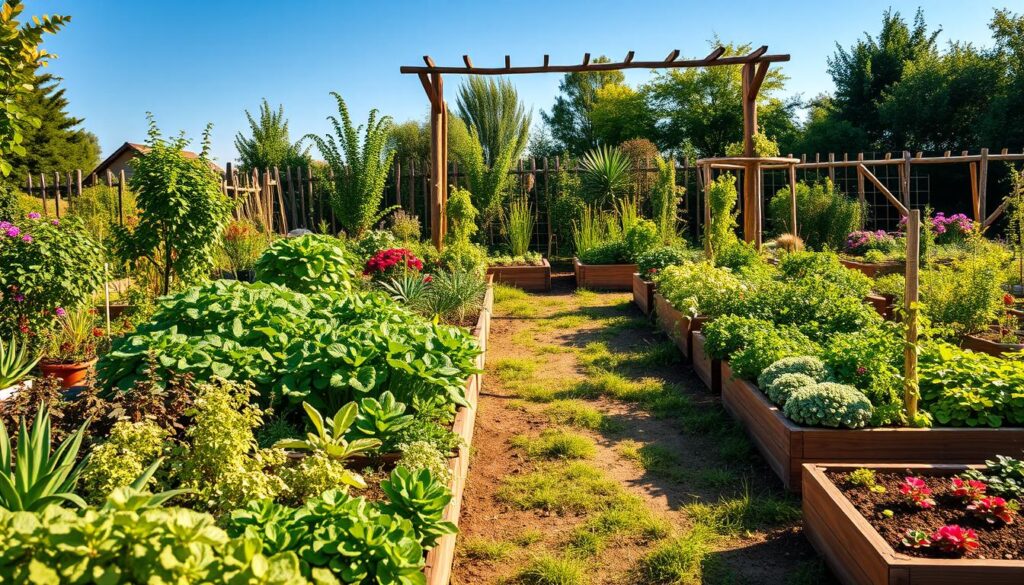
Incorporate a chicken tractor schedule to rotate poultry across your land. This method fertilizes the soil naturally while controlling pests. For pollinators, plant bee-friendly borders with lavender and echinacea. These plants attract bees, enhancing pollination for your crops.
Place your root cellar near the garden for easy access to stored produce. Calculate a rainwater collection system to conserve water and reduce reliance on external sources. Use three-sisters planting techniques to expand your yield by growing corn, beans, and squash together.
For winter protection, construct hay bale cold frames. These simple structures extend the growing season by shielding plants from frost. With these strategies, your homestead will thrive year-round.
| Element | Purpose |
|---|---|
| Chicken Tractor | Soil fertilization, pest control |
| Bee-Friendly Plants | Pollination enhancement |
| Root Cellar | Produce storage |
“A well-planned homestead combines productivity with sustainability, creating a harmonious space for both people and nature.”
8. Small Space Vegetable Garden Ideas
Maximizing limited areas for growing fresh produce is both rewarding and practical. With the right ideas, even the smallest space can become a thriving spot for your favorite plants. Whether you have a balcony, windowsill, or a tiny backyard, these tips will help you make the most of your area.
Start by prioritizing expensive crops like herbs and cherry tomatoes. These high-value plants give you the best return on your effort. Stackable 4×8 ft beds are another great solution, allowing you to grow more in a compact area. Vertical gardening techniques, such as trellises or pallet planters, also save space while adding visual interest.
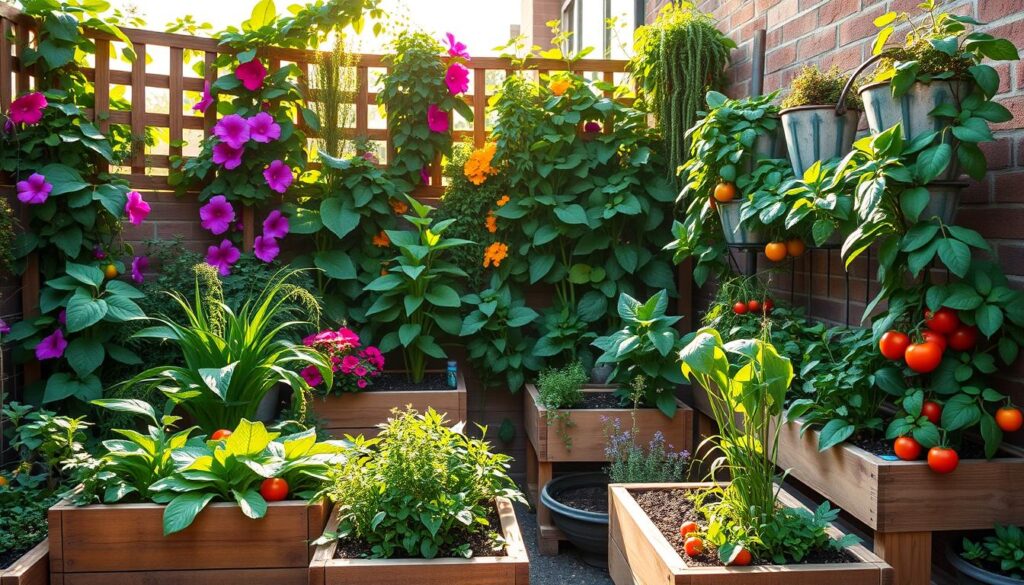
For balcony gardening, secure your plants against high winds with sturdy containers and windbreaks. Window boxes are perfect for growing herbs like basil, thyme, and parsley. If you’re short on ground space, try a tiered planter made from pallets. This DIY project is both functional and stylish.
Reflective wall surfaces can boost light for your plants, especially in shaded areas. For those in apartments, bokashi bins offer a compact composting solution. Dwarf fruit trees trained with espalier techniques are another smart choice for small spaces.
| Crop | Value per Square Foot |
|---|---|
| Basil | $5.00 |
| Potatoes | $1.50 |
“Even the smallest space can yield big rewards with thoughtful planning and creativity.”
By implementing these ideas, you can transform any small area into a productive and beautiful growing spot. From herbs to dwarf trees, the possibilities are endless.
9. Drought-Resistant Vegetable Garden Layouts
Designing a space that thrives in dry conditions requires smart strategies. By focusing on drought-resistant techniques, you can conserve water while ensuring your plants flourish. Start with xeriscaping principles, which emphasize using native and low-water types of crops.
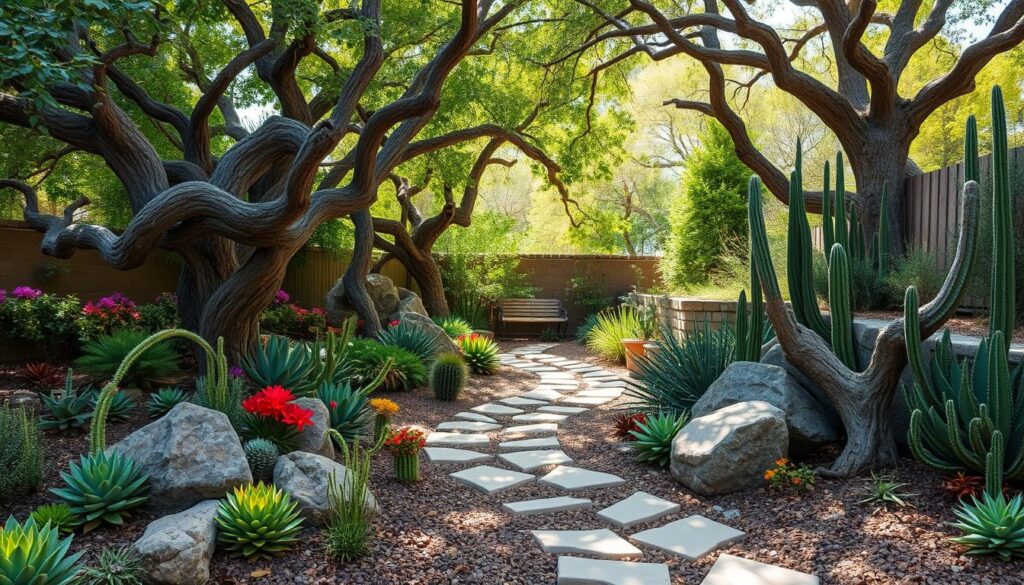
Mulching is a key step in retaining moisture. Compare rock mulch and straw mulch to see which works best for your soil. Rock mulch is durable and long-lasting, while straw mulch improves soil health as it decomposes.
For efficient watering, consider a clay pot irrigation (olla) system. This ancient method slowly releases water directly to the roots, reducing evaporation. Pair this with a drip irrigation plan for consistent hydration.
Choose heirloom varieties like Cherokee Purple tomatoes and Black Diamond watermelons. These drought-resistant plants are hardy and produce excellent yields even in arid conditions.
Install shade cloth at the right angles to protect your crops from intense sun. Swale construction can also help retain water by capturing runoff and directing it to your plants.
“Smart planning and efficient techniques make drought-resistant gardening both sustainable and productive.”
Finally, tailor your approach to your USDA hardiness zone. Arid climates require specific strategies, such as using deep-rooted plants and optimizing soil composition. With these tips, your space can thrive even in the driest conditions.
10. Conclusion: Start Planning Your Vegetable Garden Today
Getting started with your growing project is easier than you think. Begin with a printable checklist that includes site analysis, seed inventory, and essential tools. Local extension offices are a great resource for personalized advice and support.
Take inspiration from an urban gardener who doubled their first-year yield with a simple plan. Seasonal planner subscriptions can help you stay organized and maximize your harvest. Consider joining a community partnership to share knowledge and resources.
Upcoming webinars with master gardeners offer valuable tips for beginners and experts alike. Start today with a 30-minute starter plan and watch your space flourish. With the right tools and support, your journey to growing fresh vegetables is just a step away.

